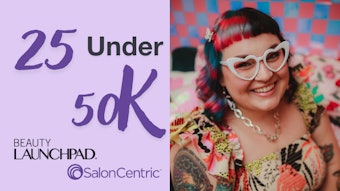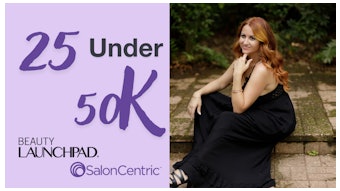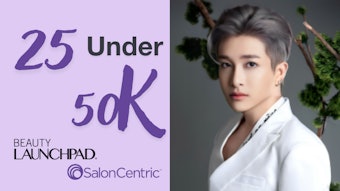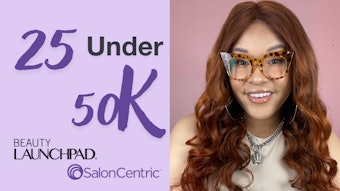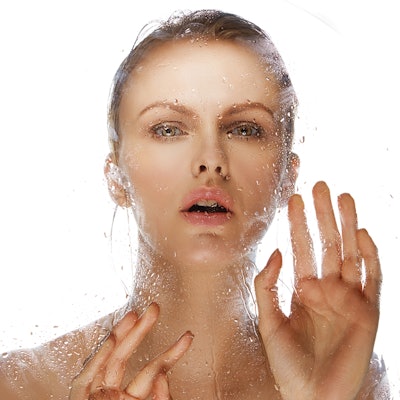
When clients develop sensitivities to glue or tape, it usually means they’ll opt out of extensions. While you may think you can’t control this outcome, think again: By adding one simple step to the end of your service you might be able to stop sensitivities dead in their tracks before they become a problem. The step in question: cleansing lashes after application.
Before you hesitate, do away with the old wives’ tale about how cleansing lashes post-application results in poor retention. “It’s a myth,” assures Doug Schoon, president of Schoon Scientific in Dana Point, California. “There’s no evidence that cyanoacrylate adhesion is going to be affected by moisture. Once it’s hardened, you get a tight seal that’s resistant to moisture.” In fact, water slowly completes the cure. Need proof? Think of nano misters: The fine spray of moisture works to accelerate the cure of any unreactive monomer, explains Schoon. “If using a nano mister after the product has set and hardened isn’t going to cause lashes to lift, why would washing?” he muses.
When you include cleansing as your last service step, you’ll not only wash away bacteria, viruses and fungus that could lead to infections, but you’ll also be ridding the lashes and skin of any potential irritants and allergens left from the product residuals, says Schoon. How do allergies come about in the first place? “Allergic reactions are caused by prolonged and repeated contact,” he says. Think: Substances that stay on the skin for hours or a day can be enough to cause an irritation that over time can develop into a permanent allergic reaction. “By washing away these traces of ingredients your body doesn’t get a chance to be irritated. Prolonged irritation is what can [lead to] an allergy,” says Schoon. Ultimately, the potential risk for developing an allergy does remain, but you’ll be reducing exposure—which can only help. “The lower the exposure and concentration, the less likely the client becomes irritated,” he adds. If your client has already developed an allergy, unfortunately nothing can be done to reverse it. “Allergies will only get worse and never better,” argues Schoon. “Washing lashes won’t lessen present allergies; rather, it’s a step toward prevention.”
RELATED: How to Correctly Answer Tough Eyelash Questions From Clients
To lift off contaminants from the lashes and skin, opt for a gentle, soapy cleansing agent (surfactant), suggests Schoon. Ensure that it’s a professional product made specifically for extensions and that it’s oil- and silicone-free. “Oil and silicone can cause the bond between the natural lash and extension to weaken,” explains Maryann Matykowski, Glad Lash training and education coordinator and owner of Soft Whisper Salon in Surprise, Arizona.
If you enjoy a long career in lashing, you’ll undoubtedly come across clients who develop sensitivities; it’s just part of the job. But Matykowski is optimistic that adding in this last cleansing step will lessen the incidences. “Hopefully it can and will keep clients in our chairs for lashes and fills instead of lash removal due to allergic responses,” she says.
RELATED: How to Deal With Dry Eye Syndrome and What it Means for Lash Extensions
Cleansing Rundown
Maryann Matykowski, Glad Lash training and education coordinator, divulges her foolproof cleansing method!
1): Allow the adhesive to set for five minutes. “If the glue isn’t dry enough it can result in white spots or a white film on the lashes (known as blooming),” says Matykowski.
2): Brush out the lashes with a spoolie. Remove any stray or loose lashes and then brush the lashes again.
3): With the client’s eyes closed, use a few drops of lash wash on a soft brush and swipe it in a downward motion from the lid to the tips of the lashes. Then use a back-and-forth motion across the lid from the inner to the outer corners to ensure you reach every last lash. Note: To lessen the chance of flooding your client’s eyes and having liquid run down her cheeks, use a small amount of cleanser and keep lint-free cotton rounds or tissues on hand so you can easily catch errant cleanser and water. “Nothing is more unsightly than having streaks in your makeup!” says Matykowski.
4): Follow the same process in Step 3 with a clean soft brush and water to remove any traces of the lash cleanser. “It’s important to remove the cleanser to eliminate any residue and ensure perfect retention,” says Matykowski.
5): Dry the lashes with a fan and brush them out neatly. “If you follow these steps, you should not have retention issues,” she says. “Lashes that aren’t clean create retention issues for sure!”
[Image: Getty Images]





